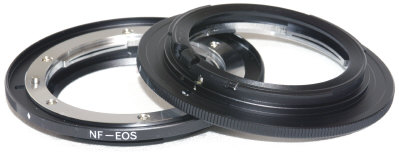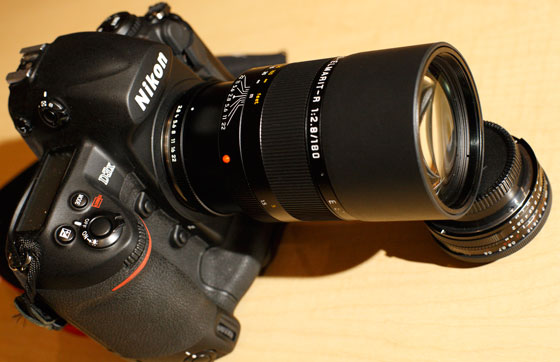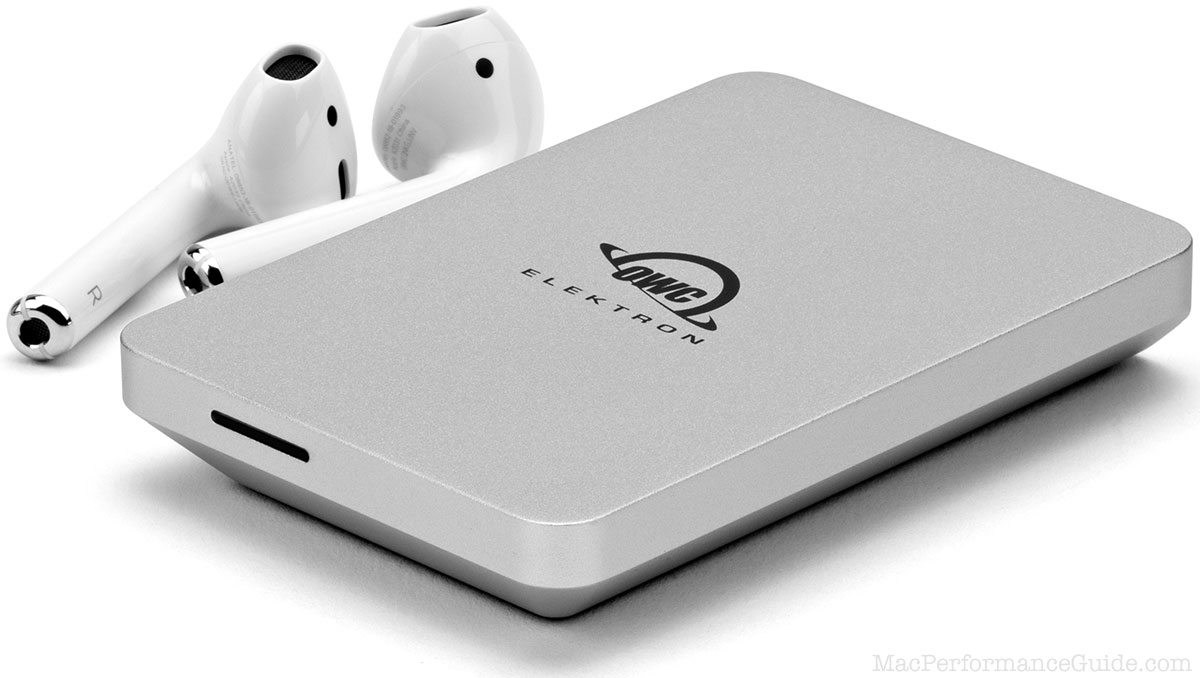

|


|

$200 Leica BP-SCL6 Lithium-Ion Battery (8.4V, 2200mAh) BACK IN STOCK in Accessories: Batteries and Power
|

|

|

|
IN STOCK!
For Sony mirrorless or Leica L.
All about lens adapters for Canon, Nikon, Sony, etc
Related: apochromatic, flange focal distance, How-To, Leica Elmarit and Elmar, Leica Elmarit-R and Elmar-R, Leica M, Leica R lenses, lens adapter, lens mount, Novoflex, Panasonic, tripods and support, Zeiss DSLR lenses
What is a lens adapter and why would I use one?

A lens adapter allows the use of a lens on a camera for which it was not designed.
For example, Canon EOS users can mount Nikon, Olympus, Leica R, Contax/Zeiss, and various medium-format lenses via the use of a lens adapter. For technical reasons (see below) Nikon users have fewer options, but there are some.
Why use a lens adapter?
No brand has an exclusively "best" set of lenses. There are always a few unique or standout lenses in any lens line; being able to use these lenses on your brand camera allows the use of the very best, whatever "best" means. Or it might simply mean that you can use lenses you already own, lenses that would otherwise sit in the closet.
Landscape shooters or those who regularly use a tripod should think hard about the possibilities: on a tripod a manually operated lens is often preferable, and this opens up possibilities for results with the top "glass" from a variety of brands.
Canon EOS users can use the Nikon-mount Zeiss ZF/ZF.2 line, but as of February 2010 nearly the entire line is now available in ZE (Canon) mount. However, a lens adapter allows the entire ZF line to be used on Canon, so buying the ZF mount allows use on both Nikon and Canon systems, for those who own both, or might later switch camera brands.
Focusing and aperture control
Most lens adapters are purely mechanical: they allow attachment of a lens to the camera body. As a result, focus must be done manually.
Of greater inconvenience is that fact that aperture control is also manual: when the lens is set at f/8, it's stopped down to f/8! You'll focus with the lens wide open (perhaps f/2), then manually stop the lens down using its aperture ring (eg f/8), then open it up to f/2 again for the next shot. This sounds tedious, but it's actually quite practical and indeed useful for tripod-based shooting (think depth of field preview). Or for countering focus shift. It's not so great for shooting moving kids.
A camera shooting an adapted lens has no idea what the actual focal length or aperture actually is, so the image won't contain that data.
A few lens adapters are fully electronic. For example, the Olympus and Panasonic adapters for four-thirds to micro-4/3 formats are fully electronic, allowing autofocus and auto aperture control. That's the exception, not the norm; it's due to to those two vendors having a commitment to the 4/3 and micro-4/3 format, with both formats being relatively new and modern. Of course, electronic adapters carry more risk of failure than simple mechanical ones.
A few lens adapters are "chipped", which might enable focus assist (eg "green dot" on Canon EOS). This isn't of much value in practice since focus assist is often too inaccurate to rely upon anyway (even without an adapter — see Focus Accuracy). Look for high mechanical quality first.
When lens adapters do not work
Nikon's new "G" lenses do not have an aperture ring; the aperture is controlled electronically. Most lens adapters are simple mechanical devices, but the 16-9.net adapter includes electronic control for G lenses (I have not tested the 16-9.net adapter).
In other cases there are mechanical collisions. Certain Leica R lenses have projecting rear metal elements that strikes the mirror of some DSLRs (bye-bye mirror). Sometimes this material can be physically removed (filed off), and sometimes it cannot be.
How many adapters?
I recommend getting one adapter for each lens you intend to use; otherwise you'll be constantly swapping the adapter, and you'll need to carry two lens caps instead of one. With the adapter in place, you'll also need a lens cap for the rear of the adapted lens.
Quality issues
Lens adapters vary widely in quality. The most basic ones are cheap aluminum of questionable thickness ("why won't my lens focus to infinity?" or "why it is blurry on one side?").
Also, many basic lens adapters have poor or no blackening and/or baffling, some have a cheap coating that flakes off, etc. Worse, flaked-off metal or paint can land on the sensor and stick there.
While "el cheapo" adapters can be had for $20 - $80, I've found none of them to be satisfactory. Some ($80 ones) wouldn't even lock onto the lens properly (that breaking glass sound was your lens hitting the concrete!). Don't take lame excuses from such vendors, just avoid them.
A well made lens adapter is all metal. Think chromed steel and/or anodized surfaces, appropriate baffling, etc. Quality costs.
A lens adapter must be a sturdy and precision device. This is particularly important when adapting a large and heavier lens. And uniform thickness of the mount to within a few microns is ultra important with wide angle lenses, where the slightest deviation will blur one side of the image.
Flange focal distance
This is a fancy way of describing the distance between the focal plane (film/sensor), and the rear lens mount. A lens adapter requires some thickness to adapt and to be sturdy. Generally speaking, a minimum of 2mm is required.
For a lens adapter to allow infinity focus, its thickness must match the difference in flange focal distance. Canon EOS bodies have a 44.0 mm flange focal distance; Nikon uses 46.5mm. That shorter distance on Canon EOS allows insertion of the lens adapter between the lens and body; that can't be done on Nikon (medium format lenses are an exception). The Nikon F to Canon EOS adapter is thus 2.5mm thick.
Common flange focal distances in millimeters (extensive list):
Canon EOS: 44.0 <=== short enough to allow many adapters
Leica R: 47.0
Leica M: 27.95
Nikon F: 46.5
Olympus OM: 46.0
Options for Nikon DSLR users Permalink
Canon EOS users have it easy—Nikon F, Leica R, Olympus OM, Contax/Yashica can be used with adapters.
Nikon users have essentially no options for lens adapters due to the flange focal distance (see above). On the plus side, most 3rd-party lenses are generally designed first (or exclusively) for the venerable Nikon "F" mount: Zeiss ZF, Coastal Optics, Voigtlander.
Many Leica R, Olympus, and certain other lenses can be used on Nikon by replacing the rear mount; this is a modification of the lens itself, not a lens adapter per se. The modification is generally reversible. See blog.
Leitax.com offers these replacement mounts for many Leica R lenses. I have four Leica R APO lenses (Leica APO lenses are world-class!), and I have converted three of them this way: the 90/2 APO-Summicron-R [review], the 100/2.8 APO-Elmarit-R macro and the 180/2.8 APO-Elmarit-R [review]. All are world-class performers and deliver astonishing results on cameras like the Nikon D3x.
Some lenses can be permanently modified to Nikon F mount, S. K. Grimes is one such company. I had an Olympus 50mm f/1.2 converted to Nikon mount with excellent results.
Nikon on Leica M
Nikon F-mount lenses can be mounted on Leica M9 cameras using the Novoflex Lens Mount Adapter - Nikon Lens to Leica M Body adapter (about $269).
I tested this solidly built adapter and it worked well in a mechanical sense. The issue is that on Leica M, there is no focusing coupling so focus can only be set by estimating distance or by shooting an image, examining it, then adjusting focus. If a future Leica M digital were to offer a Live View feature, then this adapter would be very useful in using any Nikon mount lens.
Nikon F or Leica M on Sony NEX
Nikon F-mount or Leica M lenses can be mounted on Sony NEX with a Voigtlander adapter.
Price and where to buy
My favorite brands include CameraQuest and Novoflex, both high quality—but not inexpensive.
| To fit | Adapts this type or brand | Where to buy |
|---|---|---|
| All | Lens adapters All cameras and formats |
|
| Canon EOS | Nikon F (Zeiss ZF, Voigtlander for Nikon, Coastal Optics) |
|
| Canon EOS | Leica R | |
| Canon EOS | Olympus OM | |
| Canon EOS | Contax/Yashica | |
| Nikon | Leica R Replacement mount (replaces lens mount) |
Leitax.com |
| Micro 4/3 | B&H Photo | |
| Micro 4/3 | Four-thirds Olympus MMF-1 adapter |
B&H Photo |
| Micro 4/3 | Panasonic DMW-MA1 4/3 to micro-4/3 |
B&H Photo |
| Micro 4/3 | Leica M | CameraQuest |
| Four-thirds | Olympus OM Olympus MF-1 |
B&H Photo |
| Four-thirds | All: Pentax, Contax, Leica M, Leica R | |
| Leica M | Nikon F | B&H Photo |
| Leica M | Leica R | B&H Photo |
| Sony NEX | Nikon F or Leica M or Pentax K | CameraQuest |
Ultra-high performance across entire capacity, outperforms the competition.
Tiny, bus-powered, rugged, compact!






















